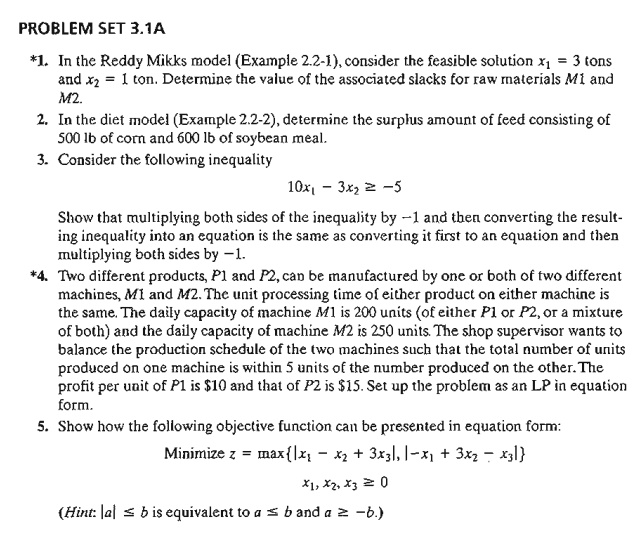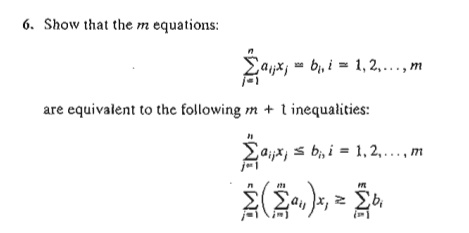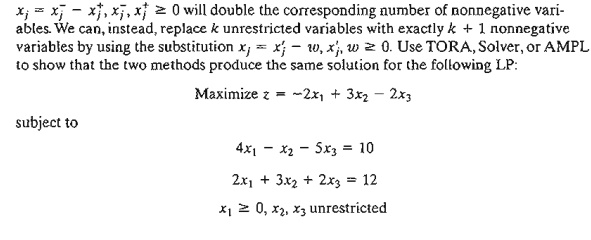Chapter: Operations Research: An Introduction : The Simplex Method and Sensitivity Analysis
LP Model in Equation Form
LP MODEL IN EQUATION FORM
The
development of the simplex method computations is facilitated by imposing two
requirements on the constraints of the problem:
1. All
the constraints (with the exception of the nonnegativity of the variables) are
equations with nonnegative right-hand side.
2. All
the variables are nonnegative.
These two
requirements are imposed here primarily to standardize and streamline the
simplex method calculations. It is
important to know that all commercial packages (and TORA) directly accept
inequality constraints, nonnegative right-hand side, and unrestricted
variables. Any necessary preconditioning of the model is done internally in the
software before the simplex method solves the problem.
1.1 Converting Inequalities into Equations with Nonnegative Right-Hand
Side
In (≤)
constraints, the right-hand side can be thought of as representing the limit on
the availability of a resource, in which case the left-hand side would
represent the usage of this limited resource by the activities (variables) of
the model. The difference between the right-hand side and the left-hand side of
the (≤) constraint thus yields the
unused or slack amount of the resource.
To
convert a (≤)-inequality to an equation, a nonnegative slack variable is added
to the left-hand side of the constraint. For example, in the Reddy Mikks model
(Example 2.1-1), the constraint associated with the use of raw material M1 is given
as
6xl
+ 4x2 ≤ 24
Defining s1 as the
slack or unused amount of MI, the constraint can be converted to the following
equation:
6x1
+ 4x2 + s1 = 24, s1 ≥0
Next, a (≥)-constraint
sets a lower limit on the activities of the LP model, so that the amount by
which the left-hand side exceeds the minimum limit represents a surplus. The conversion from (≥) to (=)
is achieved by subtracting a nonnegative surplus variable from the left-hand side of the inequality. For
example, in the diet model (Example 2.2-2), the constraint representing the
minimum feed requirements is
xl
+ x2 ≥ 800
Defining sl
as the surplus variable, the constraint can be converted to the following
equation
x1
+ x2 - SI = 800, Sl ≥ 0
The only
remaining requirement is for the right-hand side of the resulting equation to
be nonnegative. The condition can always be satisfied by multiplying both sides
of the resulting equation by -1, where
necessary. For example, the constraint

Now,
multiplying both sides by -1 will
render a nonnegative right-hand side, as de-sired-that is,
xl
- x2 - S1 = 3


2. Dealing with Unrestricted Variables
In
Example 2.3-6 we presented a multiperiod production smoothing model in which
the workforce at the start of each period is adjusted up or down depending on
the demand for that period. Specifically, if xi ( ≥ 0) is the workforce size in period i, then xi +l (≥ 0) the workforce size in period i + 1 can be
expressed as

The
variable yi+l must be unrestricted in sign to allow xi+l to increase or decrease
relative to xi depending
on whether workers are hired or fired, respectively.
As we
will see shortly, the simplex method computations require all the variables be
nonnegative. We can always account for this requirement by using the
substitution

To show
how this substitution works, suppose that in period 1 the workforce is xl
= 20 workers and that the workforce in period 2 will be increased by 5 to reach
25 workers. In terms of the variables

The
substitution also allows for the possibili-ty of no change in the workforce by
letting both variables assume a zero value.
You probably are wondering about the possibility that both y2+ and y2- may as-sume positive values simultaneously. Intuitively, as we explained in Example 2.3-6, this cannot happen, because it means that we can hire and fire a worker at the same time. This intuition is also supported by a mathematical proof that shows that, in any simplex method solution, it is impossible that both variables will assume positive values simultaneously.
PROBLEM
SET 3.1 B
1. McBurger
fast-food restaurant sells quarter-pounders and cheeseburgers. A
quarter-pounder uses a quarter of a pound of meat, and a cheeseburger uses only
.2 lb. The restaurant starts the day with 200 Ib of meat but may order more at
an additional cost of 25 cents per pound to cover the delivery cost. Any
surplus meat at the end of the day is donated to charity. McBurger's profits
are 20 cents for a quarter-pounder and 15 cents for a cheeseburger. McBurger
does not expect to sell more than 900 sandwiches in anyone day. How many of
each type sandwich should McBurger plan for the day? Solve the problem using
TORA, Solver, or AMPL.
2. Two
products are manufactured in a machining center. The productions times per unit
of products 1 and 2 are 10 and 12 minutes, respectively. The total regular
machine time is 2500 minutes per day. In anyone day, the manufacturer can
produce between 150 and 200 units of product 1, but no more than 45 units of
product 2. Overtime may be used to meet the demand at an additional cost of
$.50 per minute. Assuming that the unit profits for products 1 and 2 are $6.00
and $7.50, respectively, formulate the problem as an LP model, then solve with
TORA, Solver, or AMPL to determine the optimum production level for each
product as well as any overtime needed in the center.
*3.
JoShop manufactures three products whose unit profits are $2, $5, and $3,
respectively. The company has budgeted 80 hours of labor time and 65 hours of
machine time for the production of three products. The labor requirements per
unit of products 1,2, and 3 are 2, 1, and 2 hours, respectively. The
corresponding machine-time requirements per unit are 1,1, and 2 hours. JoShop
regards the budgeted labor and machine hours as goals that may be exceeded, if
necessary, but at the additional cost of $15 per labor hour and $10 per
ma-chine hour. Formulate the problem as an Lp, and determine its optimum
solution using TORA, Solver, or AMPL.
4. In an
LP in which there are several unrestricted variables, a transformation of the
type

Related Topics